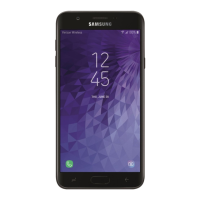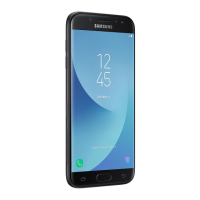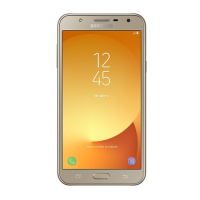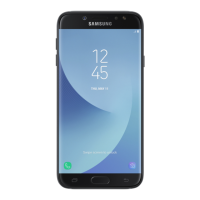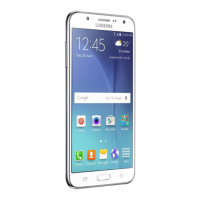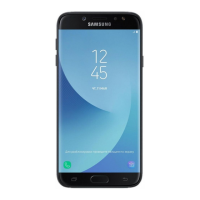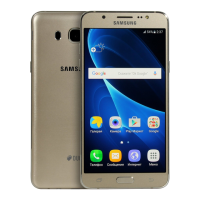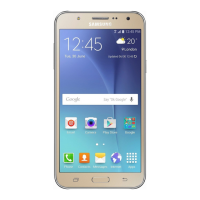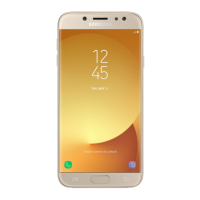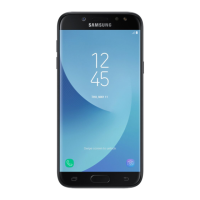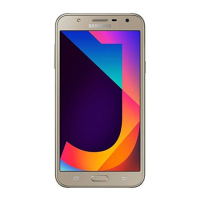Do you have a question about the Samsung SM-J727T and is the answer not in the manual?
Explains icons used in the manual for warnings, notes, and menu navigation.
Lists trademark information for Bluetooth, Java, and Windows Media Player.
Provides warnings about keeping the phone away from children and protecting hearing.
Details precautions for using the phone, including driving, medical equipment, and batteries.
Covers phone usage, battery life, SIM/memory cards, and emergency calls.
Emphasizes responsible phone use while driving, using hands-free accessories.
Warns against extreme temperatures, metal contact, and damaged chargers/batteries.
Provides guidance on protecting the phone from liquids, dust, impacts, and paint.
Explains RF energy, SAR limits, and testing procedures for FCC compliance.
Outlines the FDA's responsibilities and recommendations for wireless phone safety.
Identifies the need for further research to assess RF health risks.
Addresses concerns about children's wireless phone use and RF exposure.
Explains that hands-free kits are for convenience, not risk reduction.
Discusses the ineffectiveness of RF shielding accessories.
Provides tips for safe phone use while driving, prioritizing attention.
Recommends learning phone features to minimize distraction while driving.
Advises avoiding activities that divert attention from driving.
Explains potential interference with electronic devices and facility regulations.
Details precautions for pacemakers and hearing aids to avoid interference.
Explains the limitations and procedures for making emergency calls.
Provides step-by-step instructions on how to dial emergency numbers.
States compliance with FCC Part 15 rules and measures to correct interference.
Warns about unauthorized modifications, accessories, and physical damage.
Explains how signal strength affects call quality and reception.
Provides guidelines for operating the phone properly and maintaining service.
Offers advice on battery usage, charging, temperature, and disposal.
Instructs to check the product box for included items like the mobile phone and user manual.
Provides step-by-step instructions for installing the SIM card and battery.
Guides on how to charge the battery for the first time, including adapter connection.
Explains the warnings and actions associated with a low battery level.
Details the procedure for powering the phone on and off, including PIN entry.
Guides on navigating the phone's menus using the keypad and select/back keys.
Introduces options for personalizing phone settings like volume and ringtones.
Guides on creating custom phone profiles with specific sound settings.
Details how to choose and set a wallpaper for the home screen.
Explains how to choose and apply a theme to customize the phone's display appearance.
Details how to initiate a phone call by entering a number and pressing the dial key.
Explains how to receive an incoming call by pressing the answer key.
Describes how to activate and deactivate the speakerphone during a call.
Provides instructions for composing and sending SMS or MMS messages.
Guides on composing and sending email messages, including attaching files.
Explains how to change text input modes (ABC, T9, Number, Symbol).
Provides steps to save new contact information into the phone or SIM memory.
Guides on searching for contacts by name and performing actions like calling or editing.
Introduces Bluetooth technology for short-range wireless communication.
Details how to activate the Bluetooth feature and set phone visibility.
Explains how to deactivate the Bluetooth feature and manage visibility duration.
Explains how to send files or items to other Bluetooth-enabled devices.
Details how to receive data from other Bluetooth-enabled devices.
Provides steps to turn on the Wi-Fi (WLAN) feature to enable network connections.
Explains how to turn off the Wi-Fi (WLAN) feature to conserve battery.
Guides on searching for and connecting to available wireless local area networks.
Explains how to connect to a WLAN using WPS for a simplified setup.
Details how to enable or disable the Wi-Fi Direct feature.
Guides on setting up Wi-Fi Direct connections, scanning, and connecting to devices.
Explains how to select USB modes for PC communication and data transfer.
Lists common error messages and their corresponding troubleshooting steps.
Provides solutions for network connectivity issues and subscription-related access problems.
Offers solutions for call dialing failures, checking network access and call barring.
Discusses poor call quality due to weak signals and suggests moving to a better reception area.
Guides on troubleshooting battery charging issues, like dirty terminals or heat.
Defines M-ratings for hearing aid compatibility, indicating lower interference.
| Model | Samsung SM-J727T |
|---|---|
| Network Technology | GSM / HSPA / LTE |
| Announced | 2017, March |
| SIM | Nano-SIM |
| Display Type | Super AMOLED |
| Operating System | Android 7.0 (Nougat) |
| CPU | Octa-core 1.6 GHz Cortex-A53 |
| RAM | 2 GB |
| Internal Storage | 16 GB |
| Loudspeaker | Yes |
| 3.5mm jack | Yes |
| WLAN | Wi-Fi 802.11 b/g/n, Wi-Fi Direct, hotspot |
| Bluetooth | 4.2, A2DP, LE |
| GPS | Yes, with A-GPS, GLONASS |
| NFC | No |
| Radio | FM radio |
| USB | microUSB 2.0 |
| Sensors | Accelerometer, proximity |
| Display Resolution | 720 x 1280 pixels |
| Chipset | Exynos 7870 Octa |
| GPU | Mali-T830 |
| Main Camera | 13 MP |
| Selfie Camera | 5 MP |
| Colors | Black, Gold |
| Display Size | 5.5 inches |
